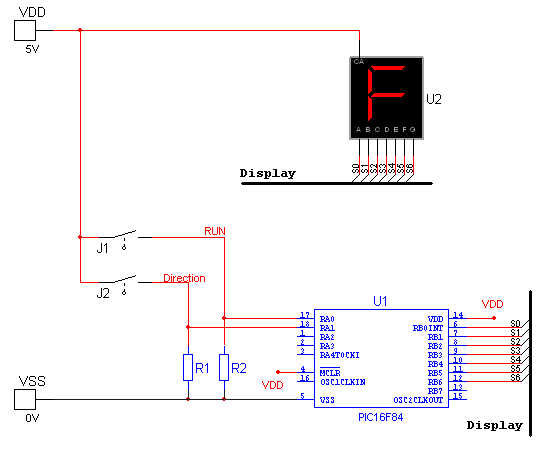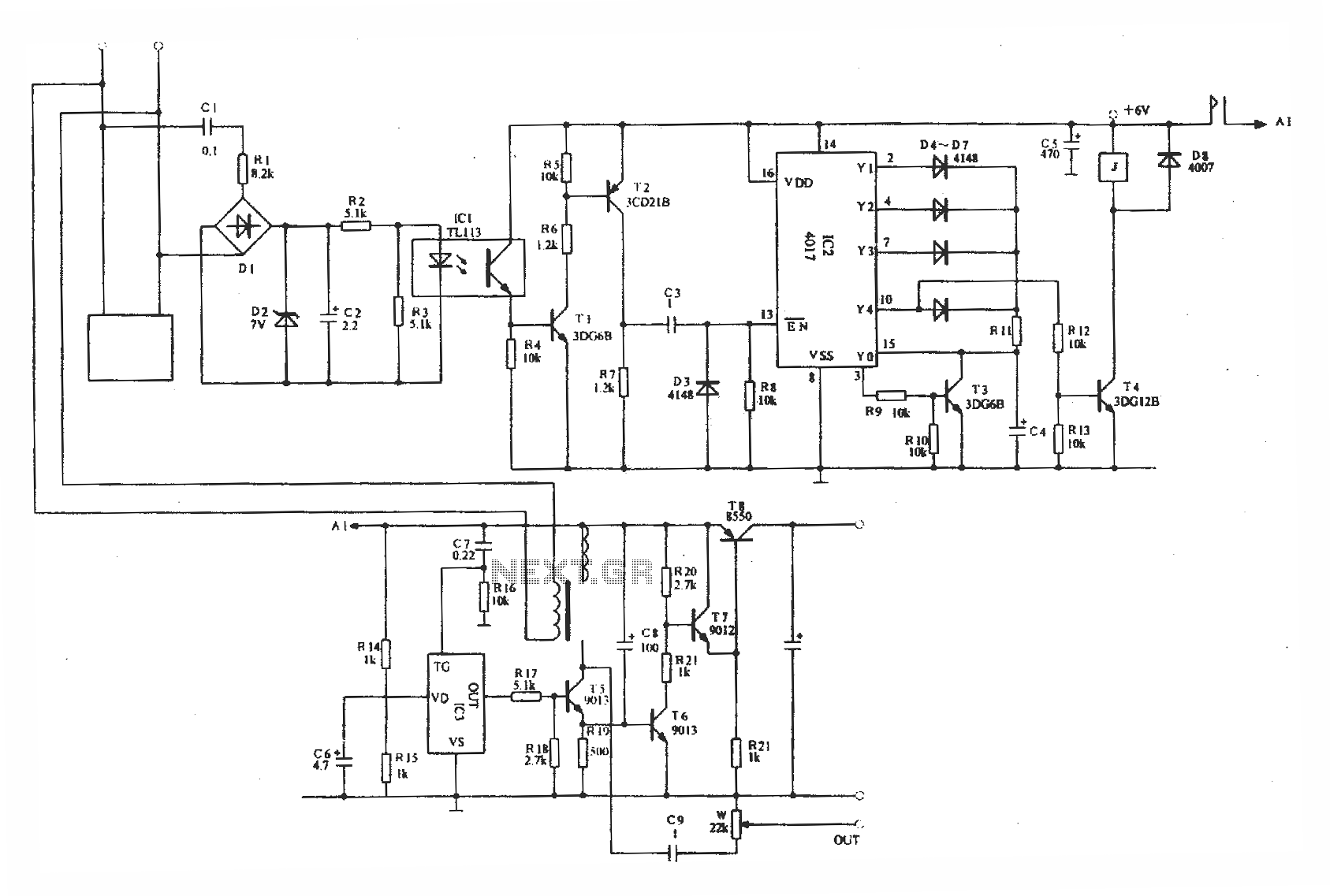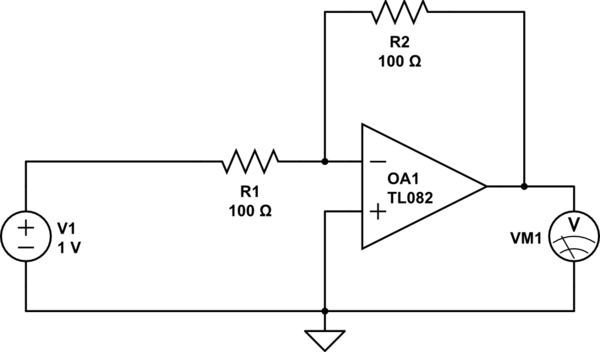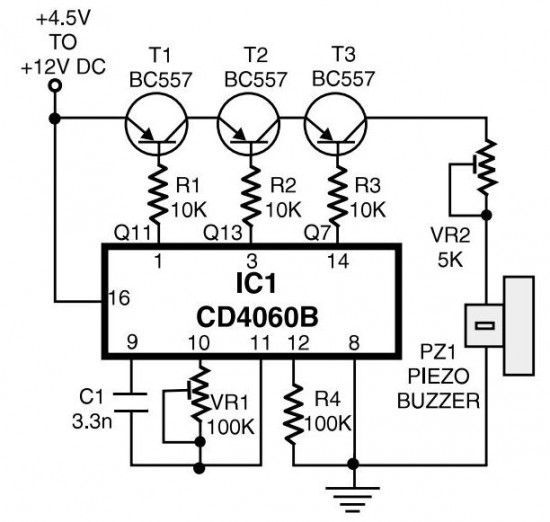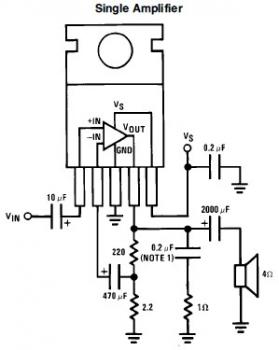
Subcarrier Adapter For Fm Tuners Circuit
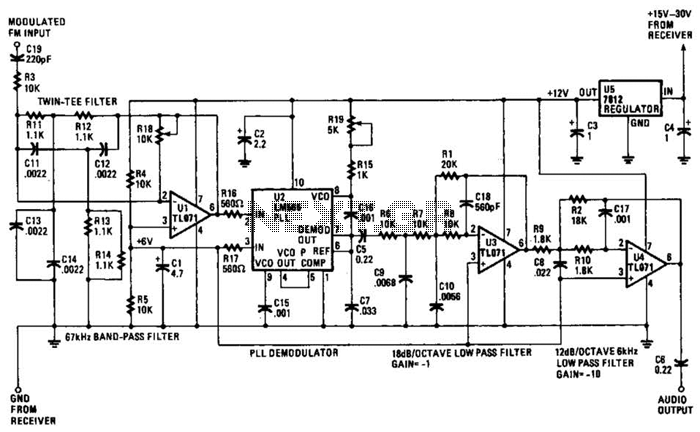
The operational amplifier (Op Amp) U1 and its associated components form a 67-kHz bandpass filter. A twin-T network, consisting of four 1100-ohm resistors and four 0.0022-microfarad capacitors, is integrated into the feedback loop of the op amp. This configuration provides gain at 67 kHz while significantly attenuating frequencies both above and below this value. Additionally, a passive filter is positioned at the input of the twin-T network, which includes a 220-picofarad capacitor and a 10,000-ohm resistor, offering further roll-off for frequencies below 67 kHz. In practical applications, the bandpass filter effectively covers a frequency range of approximately 10 kHz above and below the central frequency of 67 kHz. Resistor R18 is responsible for setting the gain of the bandpass filter stage. The integrated circuit U2 is a National LM565 phase-locked loop (PLL) that modulates the frequency-modulated (FM) signal from U1 at 67 kHz. The LM565 PLL includes a voltage-controlled oscillator (VCO) configured to 67 kHz, along with a comparator that analyzes the incoming frequency-modulated signal at pin 2 against the VCO signal fed into pin 5. The comparator's output indicates the phase difference between the incoming signal and the VCO signal, resulting in an output that is audio modulated by the subcarrier. A treble deemphasis of 150 microseconds is implemented using a 0.033-microfarad capacitor connected to pin 7. The free-running VCO frequency is influenced by the 0.001-microfarad capacitor at pin 9 and the resistance connected between the positive rail and pin 8, which is 100 ohms in series with variable resistor R19. R19 allows for adjustment of the oscillator frequency, also referred to as the center frequency, ensuring that the incoming signal remains within the lock range of the PLL.
The described circuit utilizes a bandpass filter to isolate a specific frequency range while attenuating unwanted signals. The twin-T network is a classic design for bandpass filtering, utilizing both resistors and capacitors to create a notch filter effect, which is essential for achieving the desired frequency response. The operational amplifier provides necessary gain to ensure that the signal remains strong enough for further processing. The inclusion of the passive filter at the input stage enhances the overall filtering capability, ensuring that low-frequency noise does not interfere with the desired 67 kHz signal.
The LM565 phase-locked loop plays a critical role in demodulating the frequency-modulated signal. By comparing the phase of the incoming signal with that of the VCO, the PLL can lock onto the frequency, allowing for stable demodulation. The adjustable resistor R19 provides flexibility in tuning the VCO frequency, accommodating variations in the incoming signal frequency and ensuring optimal performance of the PLL.
In summary, this circuit effectively combines filtering and modulation techniques to process a 67-kHz frequency-modulated signal, making it suitable for applications requiring precise frequency selection and demodulation. The design highlights the importance of component selection and configuration in achieving desired electronic performance characteristics. Op amp Ul and its associated components comprise the 67-kHz bandpass filter. A twin-T network, comprised of four 1100-12 resistors and four 0.0022- capacitors, is connected in the feedback network of the op amp. That gives some gain at 67 kHz and heavy attenuation for frequencies above and below that frequency. An additional passive filter at the input to the twin-T network (containing a 220-pF capacitor and a 10,000- resistor) provides some additional roll-off for frequencies below 67 kHz.
In practice, the bandpass-filter action covers a frequency range of about 10 kHz above and below the 67-kHz center frequency. Resistor R18 sets the gain of the bandpass-filter stage. Integrated-circuit U2 is a National LM565 phase-locked loop that modulates the 67-kHz fre-quency-modulated (FM) signal from Ul. The LM565 PLL consists of a voltage- controlled oscillator (VCO) set to 67 kHz, and a comparator that compares the incoming frequency-modulated 67-kHz signal at pin 2 with the VCO signal that is fed into pin 5.
The output of the comparator represents the phase difference between the incoming signal and the VCO signal. Therefore, the output is the audio modulated by the subcarrier. A treble deemphasis of 150 is provided by a 0.033- capacitor (at pin 7). The free-miming VCO frequency is determined by the 0.001- capacitor at pin 9 and by the resistance between the positive rail and pin 8 (100 in series with R19).
Variable-resistor R19 adjusts the oscillator frequency (also known as the center frequency`) so that the incoming signal is within the lock range of the PLL. 🔗 External reference
The described circuit utilizes a bandpass filter to isolate a specific frequency range while attenuating unwanted signals. The twin-T network is a classic design for bandpass filtering, utilizing both resistors and capacitors to create a notch filter effect, which is essential for achieving the desired frequency response. The operational amplifier provides necessary gain to ensure that the signal remains strong enough for further processing. The inclusion of the passive filter at the input stage enhances the overall filtering capability, ensuring that low-frequency noise does not interfere with the desired 67 kHz signal.
The LM565 phase-locked loop plays a critical role in demodulating the frequency-modulated signal. By comparing the phase of the incoming signal with that of the VCO, the PLL can lock onto the frequency, allowing for stable demodulation. The adjustable resistor R19 provides flexibility in tuning the VCO frequency, accommodating variations in the incoming signal frequency and ensuring optimal performance of the PLL.
In summary, this circuit effectively combines filtering and modulation techniques to process a 67-kHz frequency-modulated signal, making it suitable for applications requiring precise frequency selection and demodulation. The design highlights the importance of component selection and configuration in achieving desired electronic performance characteristics. Op amp Ul and its associated components comprise the 67-kHz bandpass filter. A twin-T network, comprised of four 1100-12 resistors and four 0.0022- capacitors, is connected in the feedback network of the op amp. That gives some gain at 67 kHz and heavy attenuation for frequencies above and below that frequency. An additional passive filter at the input to the twin-T network (containing a 220-pF capacitor and a 10,000- resistor) provides some additional roll-off for frequencies below 67 kHz.
In practice, the bandpass-filter action covers a frequency range of about 10 kHz above and below the 67-kHz center frequency. Resistor R18 sets the gain of the bandpass-filter stage. Integrated-circuit U2 is a National LM565 phase-locked loop that modulates the 67-kHz fre-quency-modulated (FM) signal from Ul. The LM565 PLL consists of a voltage- controlled oscillator (VCO) set to 67 kHz, and a comparator that compares the incoming frequency-modulated 67-kHz signal at pin 2 with the VCO signal that is fed into pin 5.
The output of the comparator represents the phase difference between the incoming signal and the VCO signal. Therefore, the output is the audio modulated by the subcarrier. A treble deemphasis of 150 is provided by a 0.033- capacitor (at pin 7). The free-miming VCO frequency is determined by the 0.001- capacitor at pin 9 and by the resistance between the positive rail and pin 8 (100 in series with R19).
Variable-resistor R19 adjusts the oscillator frequency (also known as the center frequency`) so that the incoming signal is within the lock range of the PLL. 🔗 External reference
